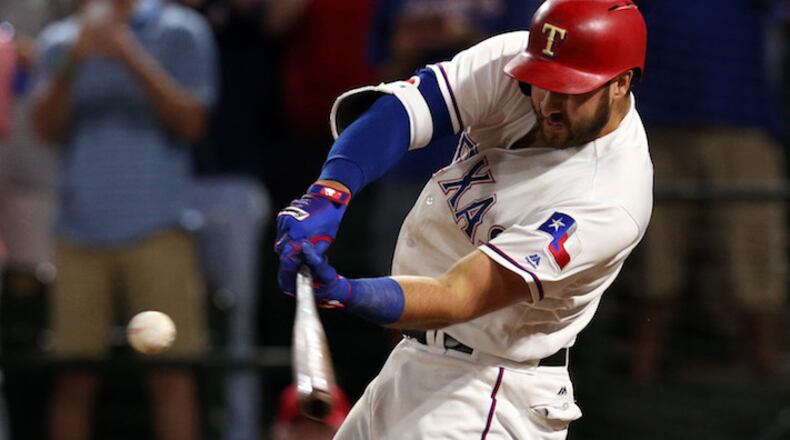Were the biggest, most troublesome bruise on Adrian Beltre's left shin a human, it would be a high school freshman who later this year would be getting its learner's permit to drive.
Oh, it's definitely alive nearly 15 years — 15 years! — after making the future Hall of Famer's leg its permanent home. It is also the reason Beltre wears a protective guard each time he takes an at-bat.
"The first one was 2003," he said. "If I get a foul ball there, it blows up."
More and more, Texas Rangers players are protecting themselves at the plate in a sport in which a generation ago almost no players went to bat with anything more than a helmet.
Players haven't become soft. On the contrary.
They want to stay on the field as much as possible, and an injury from an errant pitch or foul ball puts that in jeopardy. They want to be as assured mentally as possible that they are as safe as possible when facing a major-league pitcher.
There is no such thing as too much equipment, except, for some strange reason, the cup.
"I always like to have protection so I can get on the plate, and if I get it, it's not going to mess me up," first baseman Joey Gallo said. "You don't really even know it's there. You don't have to practice in it or anything. If I didn't have it, I'd feel naked. You just feel unprotected. You don't have it, you're thinking about it. For me, it became normal."
The Rangers don't insist that players wear protective gear, except in the case of a prior injury. All equipment must be MLB-approved, so it's not like a player can go up to bat in a suit of armor. Sometimes it looks that way, though.
Left-handed hitters who throw right-handed are the most protected, especially when facing a lefty pitcher. Lefty hitters have to stay in longer against lefties to recognize if the pitch is a fastball or a breaking ball, so their time to bail on an inside heater is reduced.
The lefty-hitting Gallo wears an elbow pad to better ensure that his throwing arm isn't injured, a shin pad, and a helmet with an extension to protect his right jaw.
"With a lefty, it's coming from behind you and you have to wait," said Gallo, who wears a regular helmet when facing right-handed pitchers. "Lefties throw high fastballs all the time, but you have to stay there because it might be a curveball. That's when you get hit in the head."
Willie Calhoun also wears the specialized helmet. The Los Angeles Dodgers told him it might be wise after he was grazed a few times on the cheek and chin by inside fastballs.
"I'm on top of the plate and I kind of step into the ball when I bat," said Calhoun, who also wears an elbow guard. "In 2016, I had a few times when pitchers went up and it. It happened three times. Ever since then I've always worn it. It gives you an extra comfort."
Rougned Odor doesn't like the Gallo-Calhoun helmet because it affects his vision, but he protects his elbow and shin. Like Beltre, Odor has a lingering bruise from a foul ball that got him in short-season A ball in 2011.
"It doesn't go away," he said.
Delino DeShields wears a guard over his left shin after experiencing the pain that comes with a foul ball off the leg. He said that a bruise doesn't slow him much, and neither does the guard, but, man, it sure is painful.
"It hurts like hell," the Rangers' fastest player said. "Mentally I can get through it. But if I got hit by a foul ball and you walked by and just nicked it, I'd want to punch you in the face. It's not a good feeling."
Jurickson Profar has the most padding because he's a switch-hitter. He has two helmets, because of vanity, and a longer interchangeable shin guard and an elbow pad for his right arm when batting left-handed.
He could have one helmet with two ear flaps.
"It's ugly," Profar said. "I like a little flow."
Odor and Shin-Soo Choo add a small pad on their right thumbs to take away the chances of breaking the finger and to reduce the sting when jammed. Choo and Robinson Chirinos will also wear padding on their right forearms, which were fractured in 2016 when hit by pitches.
"When I get to first base and take off all my stuff, the coach is like, 'Are you sure there's not more?' " Choo said.
But the cup, designed to protect a player's most sensitive area, is disappearing. Beltre, who infamously missed time in 2009 after a grounder bruised his right testicle, still won't wear a cup.
Players say they aren't comfortable, and there can be some unintended painful moments when diving head-first.
"I've never worn a cup, even when I played second base," Calhoun said. "They're just not comfortable."
But pads on just about any other vulnerable area are comfortable, and make a player mentally comfortable. Whatever it takes is fine by manager Jeff Banister, who didn't wear extra padding during his playing days in the 1980s and 1990s.
"Get hit and see how mental it is," Banister said. "There is nothing about getting hit that feels good. There's an inherent danger. We want to keep our athletes on the field. It's a comfort for hitters. Is it a hindrance? No. Does it give a hitter a little more confidence? Probably."
About the Author
Keep Reading
The Latest
Featured


